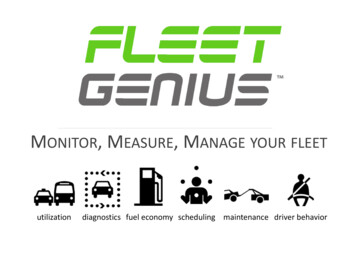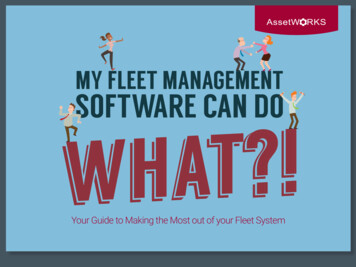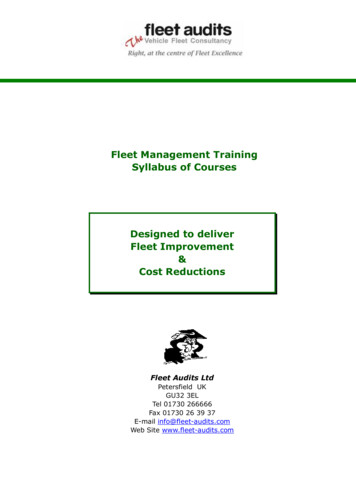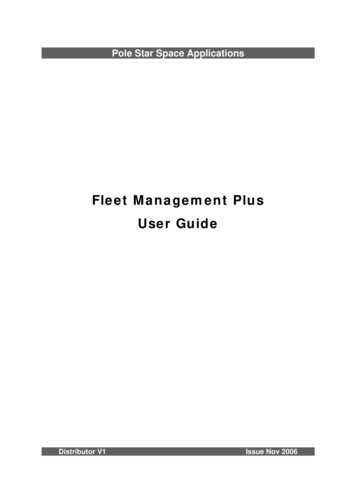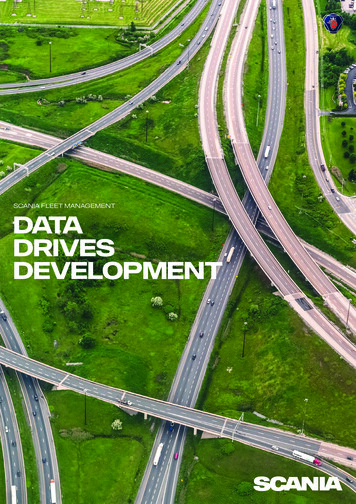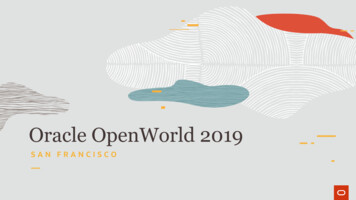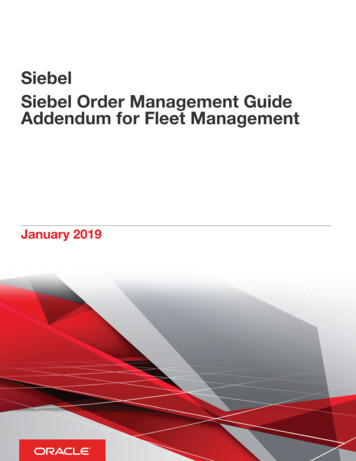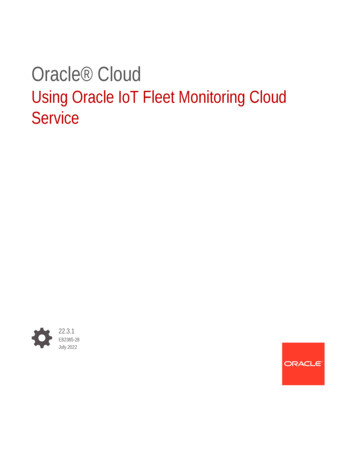
Transcription
Oracle CloudUsing Oracle IoT Fleet Monitoring CloudService22.3.1E82385-28July 2022
Oracle Cloud Using Oracle IoT Fleet Monitoring Cloud Service, 22.3.1E82385-28Copyright 2017, 2022, Oracle and/or its affiliates.Primary Author: Oracle CorporationThis software and related documentation are provided under a license agreement containing restrictions onuse and disclosure and are protected by intellectual property laws. Except as expressly permitted in yourlicense agreement or allowed by law, you may not use, copy, reproduce, translate, broadcast, modify, license,transmit, distribute, exhibit, perform, publish, or display any part, in any form, or by any means. Reverseengineering, disassembly, or decompilation of this software, unless required by law for interoperability, isprohibited.The information contained herein is subject to change without notice and is not warranted to be error-free. Ifyou find any errors, please report them to us in writing.If this is software or related documentation that is delivered to the U.S. Government or anyone licensing it onbehalf of the U.S. Government, then the following notice is applicable:U.S. GOVERNMENT END USERS: Oracle programs (including any operating system, integrated software,any programs embedded, installed or activated on delivered hardware, and modifications of such programs)and Oracle computer documentation or other Oracle data delivered to or accessed by U.S. Government endusers are "commercial computer software" or "commercial computer software documentation" pursuant to theapplicable Federal Acquisition Regulation and agency-specific supplemental regulations. As such, the use,reproduction, duplication, release, display, disclosure, modification, preparation of derivative works, and/oradaptation of i) Oracle programs (including any operating system, integrated software, any programsembedded, installed or activated on delivered hardware, and modifications of such programs), ii) Oraclecomputer documentation and/or iii) other Oracle data, is subject to the rights and limitations specified in thelicense contained in the applicable contract. The terms governing the U.S. Government’s use of Oracle cloudservices are defined by the applicable contract for such services. No other rights are granted to the U.S.Government.This software or hardware is developed for general use in a variety of information management applications.It is not developed or intended for use in any inherently dangerous applications, including applications thatmay create a risk of personal injury. If you use this software or hardware in dangerous applications, then youshall be responsible to take all appropriate fail-safe, backup, redundancy, and other measures to ensure itssafe use. Oracle Corporation and its affiliates disclaim any liability for any damages caused by use of thissoftware or hardware in dangerous applications.Oracle, Java, and MySQL are registered trademarks of Oracle and/or its affiliates. Other names may betrademarks of their respective owners.Intel and Intel Inside are trademarks or registered trademarks of Intel Corporation. All SPARC trademarks areused under license and are trademarks or registered trademarks of SPARC International, Inc. AMD, Epyc,and the AMD logo are trademarks or registered trademarks of Advanced Micro Devices. UNIX is a registeredtrademark of The Open Group.This software or hardware and documentation may provide access to or information about content, products,and services from third parties. Oracle Corporation and its affiliates are not responsible for and expresslydisclaim all warranties of any kind with respect to third-party content, products, and services unless otherwiseset forth in an applicable agreement between you and Oracle. Oracle Corporation and its affiliates will not beresponsible for any loss, costs, or damages incurred due to your access to or use of third-party content,products, or services, except as set forth in an applicable agreement between you and Oracle.
ContentsPreface12AudiencexDocumentation AccessibilityxDiversity and InclusionxRelated DocumentsxiConventionsxiGet to Know Oracle IoT Fleet Monitoring Cloud ServiceOracle IoT Fleet Monitoring Cloud Service Overview1-1Roles and Responsibilities1-2Oracle IoT Fleet Monitoring Cloud Service Business Objects1-4Monitored Business Entities1-5Oracle IoT Fleet Monitoring Cloud Service Business Process Work-Flow1-6Simulate Before You Implement1-7How to Get Support1-8Access Oracle IoT Fleet Monitoring Cloud ServiceBefore You Begin with Oracle IoT Fleet Monitoring Cloud Service2-1How You Access Oracle IoT Fleet Monitoring Cloud Service2-1How to Access Oracle IoT Fleet Monitoring Cloud Service2-3The Operation Center2-3Use the Organization Dashboard2-6Locate Your Vehicles in the Fleet Map2-8The Design CenterSettings32-92-10Connect Vehicles to Oracle IoT Fleet Monitoring Cloud ServiceDevice Models Overview3-1Upload Device Models3-3Device Overview3-6iii
456Register a Single Device3-7Register a Batch of Devices3-8About CSV Batch Registration File Properties3-9Activate a Device3-10Activating a Batch of Registered Devices3-11Install the Sample Application for Testing3-11Set Up a Freematics One Vehicle Data Logger for Testing3-14Manage DriversView Driver Details4-1Enable Driver Scoring4-1Deactivate Driver Scoring4-2Customize the Driver Scoring Key Performance Indicator4-2Add and Manage UsersCreate a New User5-2Edit a User Account5-3Reset a User Password5-4Search for a User Account5-4Delete a User Account5-5Add and Manage VehiclesCreate a Vehicle Type6-1Edit a Vehicle Type6-2View Vehicle Type Dependencies6-3Duplicate a Vehicle Type6-3Delete a Vehicle Type6-4Create a Vehicle6-4Edit Vehicle Details and Device Sensor Attributes6-5View Vehicle Dependencies6-5Delete a Vehicle6-6View Your Vehicles in the Operations Center6-6View Vehicle Information6-7View Vehicle Incidents6-7View Vehicle Alerts6-8View Vehicle Trip Information6-8View Vehicle Digital Twin Data6-9iv
7Add and Manage Trips and Trip DataWhat is a Trip?7-1How to Add Trips?7-4Create Trips Using the App UI7-4Create a Trip Using a Trip Template7-5Create a Trip Template7-6Create a Trip Without Using a Trip Template7-7Start a Trip7-9Enable Automatic Trips7-10Assign a Driver or a Vehicle to a Trip7-10View Trips Summary7-10View the Trip Templates List7-11View Trip Template Details and Preview Trip Route7-11Cancel or Complete a Trip7-11Delete a Trip7-12Manage Trips to Enable Condition MonitoringAssociate Sensors or Well-Known Assets to an Entity of a Trip7-15About Private Fleet Trips7-16About Third-Party Carrier Trips7-17Transmit Exception Events to External Systems7-18Review the Event-Notification Payload Structure7-20About Event Transmission to Oracle Transportation Management System7-24Detect Non-Communication or Connectivity Loss of Devices897-127-25Monitor Trips and Its EntitiesMonitor the Trip Dashboard8-1Examine the Map View8-2View Trip Information8-7View Ship Orders of a Trip8-8View Ship-Units of a Trip8-9View Trip Equipment Details8-10View Ship-Items of a Trip8-11Manage Incidents for a Trip8-12Review Alerts for a Trip8-14View Digital Twin Details8-15Manage Exceptions Raised for a Trip8-17Manage and Monitor Custom DashboardsCreate and View a Custom Dashboard9-1v
10Add or Remove Metrics on Custom Dashboards9-2Delete a Custom Dashboard9-3Manage Global Configuration Settings and Organization Level SettingsMonitor Data Storage and Manage Capacity Usage10-1Perform Data Management Tasks10-2Change the Map Provider10-4Set the Map Refresh Interval10-5Set the Unit of Measurement10-5Set the Currency Unit10-6Set the Fuel Cost10-6Configure the ETA Computation Settings10-7Configure Route Preferences10-7Configure Other Trip and Shipment Settings10-10Configure Mobile Application Settings10-11Customize Appearance10-11Show or Hide the Application Name10-11Add or Update an Application Logo10-12Remove an Application Logo10-12Manage Organizations10-13Change Your Current Organization10-13Create a New Organization10-13Assign Users to an Organization10-14Export and Import Organizations10-14Export an Organization10-15Import an Organization10-15Change the Map Type1110-15Use the Oracle IoT Fleet Monitoring Mobile AppUse the Mobile App as a Private Fleet Driver11-1Create a New Trip With an Existing Trip Template11-2Repeat a Recent Trip11-2Create a Custom Trip11-2Change a Vehicle Assignment11-3Start Trips11-3Start a Shipment11-4Track a Shipment11-5Apply Best Practices11-6Use the Mobile App as a Third Party Carrier's Driver11-7vi
12Install and Launch the Mobile App11-7Configure an Android Device of a Third-Party Carrier's Driver11-8Configure an iOS Device of a Third-Party Carrier's Driver11-13Start and Complete Trips or Shipments11-15Use the Truck SimulatorTypical Workflow to Monitor a Simulated Vehicle12-1Modify Stop Addresses of a Truck Simulator12-2Start a Simulated Vehicle12-4Modify the Speed of a Simulated Vehicle12-4Typical Workflow to Monitor a Simulated Shipment131412-5Monitor Shipments and FacilitiesView All Shipment Metrics13-1Use the Shipments Metrics Ribbon13-2Add a KPI to the Shipment Metrics Ribbon13-3Create a Custom Metrics Ribbon in the Shipment Map View13-3Rearrange KPI Data in the Shipment Map View13-4Edit an Existing KPI in the Shipment Map View13-4Remove a KPI from a Shipment Map View Ribbon13-5Remove a KPI Group from the Metrics Ribbon13-5View the Shipments Dashboard13-5View Shipment Details for All Shipments13-6View Shipment Details13-7View Shipment Route Details13-8View Shipment Incidents13-9Search for Shipments in the Map View13-9View Transaction Logs13-10Create a Shipment Rule13-12View All Facilities13-14View Facility Details13-14Monitor Fleet and Trip Metrics in the Fleet Map ViewUse the Fleet and Trip Metrics Ribbon14-1Add a KPI to the Fleet and Trip Metrics Ribbon14-2Add Sensor Data to the Fleet and Trip Metrics Ribbon14-2Create a Custom Metrics Ribbon in the Fleet Map View14-3Rearrange Sensor and KPI Data in the Fleet Map View14-4Edit Existing Sensor or KPI Data in the Fleet Map View14-4vii
15Remove Existing Sensor or KPI Data from a Fleet Map View Ribbon14-4Remove a Metrics Ribbon from the Fleet Map View14-5Search for Vehicles and Drivers in the Fleet Map View14-5View Vehicle or Trip Details in the Fleet Map View14-6Create Rules to Monitor IssuesCreate a Rule15-2Rules Usage Examples15-5Use Contextual Parameters in Incident Messages16171815-8Edit a Rule15-11Duplicate a Rule15-11Delete a Rule15-11Activate or Deactivate a Rule15-12Send Notifications for Incidents or AlertsAdd Your SMS Notification Account Details16-1Add Your Email Notification Account Details16-2Add the HTTP Server Details16-3Add Subscribers for the Notifications16-3Use Key Performance Indicators to Monitor the Efficiency of FleetOperationsView the KPI List17-2Create a Formula-Based Custom KPI17-3Create a Duration-Based Metric17-7Edit a Custom KPI17-10Duplicate a Custom KPI17-10Delete a Custom KPI17-11Create and Detect Geofence ViolationsCreate a New Geofence18-1Show or Hide Geofences in the Map View18-3Enable Route Geofencing18-3Set the Route Corridor Width Value18-3Set Route Deviation Tolerance Value18-4viii
1920Import and Manage FacilitiesImport Facilities from Oracle Warehouse Management Cloud Service19-1List and View Facilities19-2Update the Check-in Geofence of a Facility19-3Create Geofences for a Facility19-5Upload a Floor Plan for a Facility19-6Update the Floor Plan of a Facility19-7Create a Facility Rule19-8Integrate Oracle IoT Fleet Monitoring Cloud Service with OtherApplicationsUnderstand Built-In Integrations20-1Build Custom Integrations with REST APIs20-1Add Punch-Out URLs for Views Within Your Own Application or Web Page20-2Integrate with Oracle Transportation Management20-2Map Oracle Transportation Management Users20-3View Existing User Mapping Information20-4Connect to an Oracle Transportation Management Cloud Service Instance20-5Customize Oracle Transportation Management Cloud Service Transmission Codes20-6Set the Oracle Transportation Management Security Settings20-6Enable Transit Time Predictions for Shipments20-7Configure Your Cloud Account20-7Integrate with Oracle Object Storage Service20-8Enable Integration with Oracle Transportation Management Cloud20-9Connect to an Oracle Transportation Management Cloud Service Instance20-9Integrate with Oracle Warehouse Management Cloud Service20-11About the Integration20-11Connect to an Oracle Warehouse Management Cloud Service Instance20-12About IoT Enabled Warehouse and Transportation Management Solution20-13Integrate with Oracle Intelligent Track and Trace20-14About the Integration20-14Connect to an Oracle Intelligent Track and Trace Instance20-15ix
PrefacePrefaceUsing Oracle IoT Fleet Monitoring Cloud Service provides information and proceduresfor using Oracle IoT Fleet Monitoring Cloud Service. Oracle IoT Fleet Monitoring CloudService lets you monitor and manage your fleet.Topics: Audience Documentation Accessibility Diversity and Inclusion Related Documents ConventionsAudienceUsing Oracle IoT Fleet Monitoring Cloud Service is intended for Fleet Managers whoare responsible for managing their fleet.Documentation AccessibilityFor information about Oracle's commitment to accessibility, visit the OracleAccessibility Program website at http://www.oracle.com/pls/topic/lookup?ctx acc&id docacc.Access to Oracle SupportOracle customers that have purchased support have access to electronic supportthrough My Oracle Support. For information, visit http://www.oracle.com/pls/topic/lookup?ctx acc&id info or visit http://www.oracle.com/pls/topic/lookup?ctx acc&id trsif you are hearing impaired.Diversity and InclusionOracle is fully committed to diversity and inclusion. Oracle respects and values havinga diverse workforce that increases thought leadership and innovation. As part of ourinitiative to build a more inclusive culture that positively impacts our employees,customers, and partners, we are working to remove insensitive terms from ourproducts and documentation. We are also mindful of the necessity to maintaincompatibility with our customers' existing technologies and the need to ensurecontinuity of service as Oracle's offerings and industry standards evolve. Because ofthese technical constraints, our effort to remove insensitive terms is ongoing and willtake time and external cooperation.x
PrefaceRelated DocumentsFor more information, see these Oracle resources: Oracle Cloud at http://cloud.oracle.com Getting Started with Oracle CloudConventionsThe following text conventions are used in this document:ConventionMeaningboldfaceBoldface type indicates graphical user interface elements associated with anaction, or terms defined in text or the glossary.italicItalic type indicates book titles, emphasis, or placeholder variables for whichyou supply particular values.monospaceMonospace type indicates commands within a paragraph, URLs, code inexamples, text that appears on the screen, or text that you enter.xi
1Get to Know Oracle IoT Fleet MonitoringCloud ServiceWelcome to Oracle IoT Fleet Monitoring Cloud Service. Oracle IoT Fleet Monitoring CloudService is a cloud-based service that provides you real-time end-to-end transportationvisibility and insights into business entities, such as vehicle location, condition of containers,status of in-transit inventory, cargo condition, operational costs, vehicle use, and drivingbehavior.Oracle IoT Fleet Monitoring Cloud Service OverviewOracle Internet of Things (IoT) Fleet Monitoring Cloud Service helps you track the locationand activity of fleet assets. Sensors connected to the on-board diagnostic (OBD) port in eachfleet asset use cellular, satellite, or Bluetooth connections to transmit real-time vehiclelocation and performance data to Oracle IoT Fleet Monitoring Cloud Service. You can usereal-time and historic vehicle location and performance data to determine where changes canbe implemented to improve customer satisfaction, reduce operating costs, and increasedriver safety.For complete transportation monitoring of a supply chain network, Oracle Internet of Things(IoT) Fleet Monitoring Cloud Service provides you visibility of private fleet or third party carriertrips for Real-time location and condition of vehicles, trailers, and containers moving freight In-transit cargo and inventory condition and their insights Predictions for estimated time of arrival (ETA) of trips Driver behavior and vehicle usageYour business requirements determine how you use Oracle IoT Fleet Monitoring CloudService. You might want to focus on the reduction of fuel costs, plan more efficient deliveryroutes, or keep in touch with drivers more frequently. Oracle IoT Fleet Monitoring CloudService provides a user interface that is designed to let you focus on the data that isimportant to you. Let’s take a look at some of these features.The map view identifies the location of every fleet asset in real-time. Knowing the location ofa vehicle in real-time lets you more accurately predict the estimated time of arrival (ETA),improve route planning efficiency, and reduce idle time and fuel consumption.The prebuilt business dashboards and predefined key performance indicators (KPIs) help youmonitor fleet performance — availability, active trips, fuel costs, utilization, speed violations,and more. Knowing the condition of each fleet asset helps you schedule regular repair andservicing and avoid downtime.Rules can help you track fuel consumption, battery life, tire pressure, engine oil level, enginetemperature, and more. Rules can also help you influence good driver behavior by monitoringspeed violations, harsh braking, and route deviations.Use the Oracle IoT Fleet Monitoring Cloud Service to:1-1
Chapter 1Roles and Responsibilities Gain Real-Time Fleet Visibility–Track and locate vehicles in transit, and get current vehicle on-board sensordata.–View map-based, interactive visualizations of vehicles, equipment, shiporders, ship-units, and ship-items associated with trips.–Leverage built-in KPIs for fleet status, utilization, availability, fuel costs,exceptions, and policy violations.–Use certified partner devices plugged directly into your vehicle, and securelycollect and transmit vehicle on-board sensor data.Improve ETA Predictions and Reduce Vehicle Downtime–Continuously monitor vehicle on-board sensor data to detect faults anddiagnose alerts.–Improve customer experiences with better ETA predictions and potentialvehicle failure predictions.–Manage timely resolution of issues via effective incident management.–Gain contextualized visibility and notifications on the mobile app.–Apply feature-based machine learning on data from Oracle TransportationManagement Cloud to determine insights and transit time predictions forplanned shipments.Monitor Vehicle Usage–Create geofence boundaries to specify vehicle usage areas.–Get instantly notified when vehicle movement violates geofence boundaries.–Monitor vehicle idle time to reduce fuel costs and complete trips faster.Plug in to the Supply Chain–Integrate with Oracle Transportation Management Cloud and OracleWarehouse Management Cloud to pull in trip or shipment information, sendinformation about vehicles in transit, and import facilities.–Automatically generate incidents and alerts in supply chain managementapplications to handle issues such as shipment delays and vehiclebreakdowns.–Digitally transform your fleet management processes with complete real-timevisibility across all aspects of your fleet.Roles and ResponsibilitiesHow you interact with Oracle IoT Fleet Monitoring Cloud Service is dependent on yourassigned role and access privileges.1-2
Chapter 1Roles and ResponsibilitiesRoleResponsibilitiesAdministrator (IoTAdministrator)This role is common across all the apps of Oracle IoT IntelligentApplications. Viewer (IoTViewer)Create and manage organizationsCreate users in the application, manage their rolesManage users of an organizationManages vehicles and active trips.Responds to and resolves incidents and alerts.Creates rules to monitor vehicle and driver performance.Creates geofences to prevent misuse of fleet assets and theft.Creates and modifies trip templates and trips.Sets and modifies application settings including monetary andmeasurement units.Uploads vehicle, trip, device model, and user mapping data.Uses key performance indicators (KPIs) to determine the efficiency offleet operations including fuel costs and vehicle utilization.This role is common across all the apps of Oracle IoT IntelligentApplications. View operations center entities of an organization such as– dashboards– digital twins– notificationsA non-admin user should have a Viewer role in order to access the OracleIoT management console (/ui)Technician(IoTTechnician)This role is common across all the apps of Oracle IoT IntelligentApplications. Create and manage entity instances in an organizationConfigure connectivity by creating connectors, download the schemaand creating the interpreter.Troubleshooting issues, resolve incidents, view associated rules.Access digital twin entities, execute actions and what ifs.Access assets inventory and edit their custom attributes.Integrator (IoTIntegrator) This role is common across all the apps of Oracle IoT IntelligentApplications. Integrates Oracle IoT Fleet Monitoring Cloud Service with otherapplications and cloud services such as Oracle TransportationManagement, Warehouse Management, and so on.Configure the external application to allow it to access Oracle IoT FleetMonitoring Cloud ServiceLogistics Operator(IoTLogisticsOperator)This role is applicable only for Oracle IoT Fleet Monitoring Cloud Service.Driver (IoTDriver)This role is applicable only for Oracle IoT Fleet Monitoring Cloud Service.View operations center entities Views, creates, and manages trips. view incidents, exceptions, alerts and their associated rules. Has read access to all operation center views, such as dashboards,vehicles, drivers, facilities, shipments, and shipment transaction logs. View digital twins of all entitles and their sub-entities. Creates new trips.Manages vehicle assignments.Starts shipments.Stop or complete trips or shipments and add comments1-3
Chapter 1Oracle IoT Fleet Monitoring Cloud Service Business ObjectsRoleResponsibilitiesShipper (IoTShipper)This role is applicable only for Oracle IoT Fleet Monitoring Cloud Service. Tracks and monitors shipments, trips, and facilities.Oracle IoT Fleet Monitoring Cloud Service Business ObjectsA business object is an object within a computer application that represents a part ofthe business or an item within it. These business objects let you collect, view, manage,and analyze business data. A vehicle is a business object within the Oracle IoT FleetMonitoring Cloud Service. Using business objects simplifies data management byencapsulating the data associated with the business entity it represents.The structure, relationships, and attributes of business objects are stored in theschema of your database. Your development team manually defines the attributes ofthe predefined Oracle IoT Fleet Monitoring Cloud Service business objects. Forexample, the vehicle identification number (VIN), make, model, and year for each ofthe vehicles in your fleet. When you view a vehicle business object in Oracle IoT FleetMonitoring Cloud Service, the defined attributes are displayed. To allow administratorto update, create, and delete business objects, your development team has created aset of actions that let them add create, edit, and update business object data. Whenthe administrator modifies business objects, the schema and tables in the databaseare automatically updated.You can track, monitor, and perform analytics on business objects. Some businessobjects such as vehicles and drivers are predefined in the application and others suchas shipments and facilities must be imported from external systems. Optionally, youcan create custom business entities such as key performance indicators (KPIs) toanalyze your data and develop predictive analytics.This table lists the Oracle IoT Fleet Monitoring Cloud Service business objects.Business Creation Supported in theObjectApplication?Imported from an ExternalSystem?OptionalBusiness Object?AlertDriverGeofenceFacilityIncidentMetrics alDataOrganization1-4
Chapter 1Monitored Business EntitiesBusiness Creation Supported in theObjectApplication?Imported from an ExternalSystem?OptionalBusiness ip-UnitShip-ItemMonitored Business EntitiesUse the Oracle IoT Fleet Monitoring Cloud Service to monitor trips, shipments, vehicles,equipment in vehicles, ship-orders, ship-units or packages, ship-items, and the driversassigned to a trip.TripsA trip is the primary entity of Oracle IoT Fleet Monitoring Cloud Service that has multiple subentities such as stop locations, vehicle, drivers, equipment, ship-orders, ship-units, and shiporders. In real-time, as an administrator, you can perform location monitoring and inventorycondition monitoring of the trip including all its sub entities. A trip can be created within theapplication or imported from an external application such as Oracle TransportationManagement Cloud Service.VehiclesConnect a data logger to the OBD-II of a fleet vehicle to send vehicle data to the Oracle IoTFleet Monitoring Cloud Service. By tracking vehicle performance in real time, you canschedule repair and service and avoid costly breakdowns. As an administrator you knowwhere every vehicle is located and if it is operating efficiently.EquipmentEquipment is a sub-entity of a trip such as, a trailer or a container. It is part of an imported tripand the equipment can be associated with a well-known equipment asset created andmaintained in Oracle IoT Asset Monitoring Cloud Service or it can be associated with atracking sensor in Oracle IoT Fleet Monitoring Cloud Service. This tracking sensor of anequipment allow you to monitor its life-cycle and condition within the life-cycle of the trip.Ship OrdersA ship order is a sub-entity of a trip and contains information including source location,destination location, pickup dates, status, special instructions, and measurements, such as,weight or volume. An imported trip can contain one or more ship orders.1-5
Chapter 1Oracle IoT Fleet Monitoring Cloud Service Business Process Work-FlowShip UnitsA ship-unit is a sub-entity of a trip and contains information such as, commodity,hazardous or not, measurements, count, type, and so on. There can be one or moreship units in a ship order. A trip can contain multiple ship-units, each belonging tomultiple ship-orders of that trip. A ship-unit can either be associated with a well-knownpackage asset created and maintained in Oracle IoT Asset Monitoring Cloud Serviceor it can be associated with a sensor in Oracle IoT Fleet Monitoring Cloud Service.Ship ItemsA ship-item is inventory that contains information such as quantity, commodity,measurements, hazardous or not, and so on. One or more ship-items can belong to aship-unit and each ship-item is associated with a ship-order. A ship-item can either beassociated with a well-known item asset created and maintained in Oracle IoT AssetMonitoring Cloud Service or it can be associated with a sensor in Oracle IoT FleetMonitoring Cloud Service. Its sensor devices help you monitor its condition andlocation.DriversGood driver behavior can reduce repair and service maintenance costs. As anadministrator, you can implement rules and geo-fences to enforce good driverbehavior. For example, you can implement rules that relay information about driversexceeding speed limits, hard braking, or driving for too many hours. Geofence rulesmake sure drivers do not deviate from the assigned route.Oracle IoT Fleet Monitoring Cloud Service BusinessProcess Work-FlowA work-flow, or a business process, is a collection of tasks that you complete toconfigure the cloud service to meet the unique requirements of your business. Thetypical tasks you complete are represented visually in the diagram and links to eachtask or collection of tasks are provided in the table below the diagram.Oracle IoT Fleet Monitoring Cloud Service monitors, collects, transmits, and analyzesvehicle data. To perform predictive analytics that identify issues before they disruptservice to your customers, you can use the included key performance indicators (KPIs)or you can create your own custom KPIs to meet the unique requirements of yourbusiness. You can also create custom rules that notify you of abnormal vehicleconditions in real time. Knowing when a vehicle requires maintenance helps with thedevelopment of maintenance schedules and this reduces or eliminates servicedisruptions due to unscheduled maintenance or breakdowns.The real-time data collected by Oracle IoT Fleet Monitoring Cloud Service helps youoptimize vehicle performance, improve driver safety, and increases customersatisfaction. You’ll know the location of every vehicle in your fleet and you’ll know ifyour drivers are complying with your policies.Integration with Oracle Transportation Management makes it easier to access andshare Oracle Transportation Management shipment data. Application integrationincreases efficiency and provides a better customer experience because you alwaysknow the location of a shipment. Integrations also let you realize the full benefit of yoursoftware investment and let you use all of the data you collect as fully as possible.1-6
Chapter 1Simulate Before You ImplementThis image represents the work-flow for using Oracle IoT Fleet Monitoring Cloud Service:Note:Familiarize yourself with the Oracle IoT Fleet Monitoring Cloud Service OperationCenter, Design Center, and App Settings before performing these tasks. SeeAccess Oracle IoT Fleet Monitoring Cloud Service for more information.TaskDescriptio
Get to Know Oracle IoT Fleet Monitoring Cloud Service. Oracle IoT Fleet Monitoring Cloud Service Overview1-1. Roles and Responsibilities1-2. Oracle IoT Fleet Monitoring Cloud Service Business Objects1-4. Monitored Business Entities1-5. Oracle IoT Fleet Monitoring Cloud Service Business Process Work-Flow1-6. Simulate Before You Implement1-7. How .

